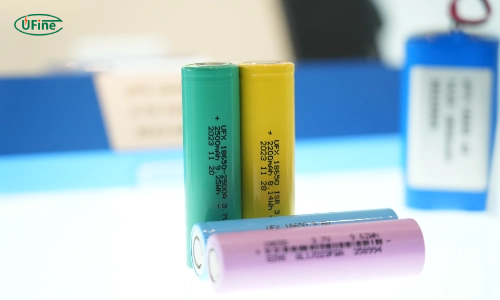In today’s tech-driven world, 3.7 Volt batteries are ubiquitous, powering many devices from smartphones to drones. Understanding these batteries’ various sizes and specifications is crucial for anyone looking to replace, upgrade, or learn more about the batteries that keep their gadgets running. This comprehensive guide will delve into the different sizes of 3.7 Volt batteries, their applications, and what to consider when choosing the right one for your needs.
Part 1. What is a 3.7V battery?
A 3.7V battery is a rechargeable lithium-ion battery that provides a steady voltage output and is commonly used in electronics such as smartphones, drones, and cameras.
Advantages of 3.7 Volt Batteries
3.7-volt batteries offer several advantages over traditional disposable batteries:
- Rechargeability: You can reuse this hundreds of times, reducing waste and cost.
- Higher Energy Density: Provide more power in a smaller and lighter package.
- Consistent Performance: Maintain stable voltage output throughout the discharge cycle.
- Environmentally Friendly: Minimize environmental impact compared to disposable batteries.
Challenges and Considerations of 3.7 Volt Batteries
Despite their advantages, 3.7-volt batteries have some limitations:
- Temperature Sensitivity: Performance may degrade in extreme temperatures.
- Safety Concerns: Improper handling or charging can lead to overheating and safety hazards.
- Initial Cost: Higher upfront cost than disposable batteries, but cost-effective in the long run.
Part 2. Common 3.7-volt battery sizes
Different Types of 3.7V Batteries and Their Sizes
Popular 3.7V battery types include the 18650, 14500, and 26650, each varying in energy storage and dimensions, suitable for specific applications like laptops, power tools, and flashlights.
1. 18650 Battery
18650 batteries stand as stalwarts in rechargeable power solutions, characterized by their cylindrical form factor with dimensions of 18mm in diameter and 65.0mm in length. They are widely acclaimed for their:
- High Energy Density: Offering a potent blend of capacity and energy storage efficiency.
- Versatility: Finding extensive use in consumer electronics like laptops, flashlights, and electric vehicles.
- Reliability: Known for their long cycle life and stable performance under demanding conditions.
2. 14500 Battery
Resembling the dimensions of AA batteries, 14500 batteries measure 14mm in diameter and 50.0mm in length. Despite their compact size, they pack a punch with:
- Space Efficiency: Ideal for devices where size constraints dictate the choice of power source.
- Application Range: Commonly employed in smaller electronics such as flashlights, toys, and medical devices where portability and reliability are paramount.
- Performance: Delivering adequate power for moderate-energy-consumption devices.
3. 26650 Battery
At the larger end of the spectrum, 26650 batteries feature robust cylindrical cells with 26mm in diameter and 65.0mm in length. They excel in:
- High Capacity: Offering substantial energy storage capabilities suitable for prolonged power supply applications.
- Durability: Designed to withstand high-drain scenarios, making them ideal for power tools and solar energy storage systems.
- Longevity: Known for their extended lifespan and reliability in intensive use environments.
4. 16340 Battery (RCR123A Battery)
Compact yet powerful, 16340 batteries (also known as RCR123A batteries) feature a 16mm diameter and 34.0mm length. Many people favour them for the following reasons:
- Portability: Providing efficient power solutions in compact electronic devices like cameras, flashlights, and portable gadgets.
- Performance: Despite their size, they deliver reliable power output, making them indispensable in applications where space is at a premium.
- Versatility: Suitable for a wide range of electronic devices requiring compact and efficient power sources.
5. 21700 Battery
The 21700 battery is a newer, larger format gaining popularity due to its enhanced capacity and energy density. Measuring 21mm in diameter and 70mm in length, the 21700 battery offers:
- Higher Capacity: With capacities often exceeding 4000mAh, they provide longer runtimes for devices.
- Improved Energy Density: More efficient energy storage compared to older formats.
- Wide Application Range: Commonly used in electric vehicles, high-performance flashlights, and other applications requiring substantial power.
6. 10440 Battery
Similar in size to AAA batteries, the 10440 battery measures 10mm in diameter and 44mm in length. These batteries are ideal for:
- Compact Devices: Perfect for small electronics that require a lightweight and space-efficient power source.
- Portable Gadgets: Portable media players, small flashlights, and other miniature devices use these.
- Moderate Energy Needs: Suitable for devices that don’t require high current draw but benefit from rechargeable options.
The most common sizes of 3.7V batteries include 18650, 14500, and 26650. Each battery has distinct applications based on energy storage, size, and usage requirements. While the 18650 is popular in laptops, the compact 14500 fits smaller devices like flashlights.
Part 3. Different 3.7-volt battery sizes applications
Key Applications of 3.7V Batteries
3.7V batteries are commonly used in drones due to their compact size and consistent power delivery. Devices like electric vehicles also use 3.7V lithium-ion cells for efficiency and longer-lasting energy supply.
18650 Battery applications
- Laptops: The high capacity and rechargeability of 18650 batteries make them ideal for powering laptops.
- Flashlights: Their size and power output are perfect for high-lumen flashlights.
- Electric Vehicles: Due to their energy density and long cycle life, they are used in battery packs for electric vehicles.
- Power Banks: High-capacity power banks often use 18650 cells to provide portable charging solutions.
14500 Battery applications
- Small Flashlights: The compact size of the 14500 battery makes it suitable for small, portable flashlights.
- Portable Electronics: Devices like wireless mice and small handheld devices often use these batteries.
- Medical Devices: These are essential in portable medical equipment where size and reliability are critical.
26650 Battery applications
- High-Powered Flashlights: The larger size allows for higher capacity, making them suitable for powerful flashlights.
- Vaping Devices: Some high-capacity vaping devices use 26650 batteries for extended usage.
- Power Tools: Their durability and high-drain capabilities make them ideal for cordless power tools.
16340 Battery applications
- Cameras: Compact cameras and other portable imaging devices benefit from the small size and reliable power of 16340 batteries.
- Flashlights: Ideal for small, high-intensity flashlights.
- Security Devices: Security sensors and alarm systems use these due to their compact size and reliable performance.
21700 Battery applications
- Electric Vehicles: The high capacity and power output of 21700 batteries make them ideal for electric vehicle battery packs.
- High-Performance Flashlights: Flashlights that require more power and longer runtimes use them.
- Energy Storage Systems: Employed in home and industrial energy storage solutions.
10440 Battery applications
- Miniature Electronics: Perfect for small gadgets and devices where space is at a premium.
- Portable Media Players: Small, portable media players use these for efficient power.
- Remote Controls: Ideal for remote controls and other low-energy devices.
Whether powering a small flashlight or a high-tech drone, choosing the correct 3.7v battery size is critical for optimal performance. Consider larger 3.7v lithium-ion batteries that offer longer runtimes for more power-hungry devices like electric vehicles.
Part 4. How to choose the correct 3.7-volt battery?
When selecting a 3.7-volt battery, consider the following factors:
1. Determine the Required Capacity
First, identify your device’s energy requirements. A higher-capacity battery (measured in mAh) will last longer and be larger and heavier.
2. Consider the Size Constraints
Make sure the battery fits within your device’s physical dimensions. Measure the battery compartment and compare it with the battery’s dimensions.
3. Check the Discharge Rate
The discharge rate, measured in amperes (A), indicates how quickly the battery can release energy. High-drain devices will need batteries with higher discharge rates.
4. Evaluate the Brand and Quality
Opt for reputable brands known for producing high-quality batteries. Cheap, no-name batteries may have inconsistent performance and could be unsafe.
5. Safety Features
Look for batteries with built-in safety features such as overcharge protection, over-discharge protection, and short-circuit protection.
6. Verify Voltage and Chemistry Compatibility
Ensure the battery’s voltage and chemistry (e.g., lithium-ion vs. lithium-polymer) are compatible with your device’s requirements. Using an incompatible battery can damage your device or pose safety risks.
7. Certifications and Standards
Choose batteries that comply with industry standards and certifications, such as UL, CE, and RoHS. Certified batteries have been tested for safety and performance, providing peace of mind.
Artikel Terkait: What is the Self Discharge Rate of Li-ion Battery?
Part 5. FAQs
-
How can you prevent lithium batteries from exploding?
To prevent lithium batteries from exploding, avoid physical damage, overcharging, overheating, and using damaged batteries. Also, follow proper charging practices, store them in a cool, dry place, and avoid exposure to extreme temperatures or conditions. -
How do you stop a LiPo battery from a fire?
In the event of a LiPo battery fire, immediately disconnect the battery from its power source and move it away from flammable materials. Use a Class D fire extinguisher or a fire-resistant container for LiPo fires to contain and smother the flames. -
How do you store LiPo batteries at home?
Store LiPo batteries in fireproof containers or LiPo-safe bags, ideally in a cool, dry place away from direct sunlight or heat sources. Ensure they are stored at storage charge levels, typically around 3.8V to 3.85V per cell, to prevent degradation. -
Which lithium batteries are prone to fire?
Lithium batteries, particularly LiPo (lithium polymer) batteries, are more prone to fire or explosion if mishandled, damaged, overcharged, or exposed to extreme conditions compared to other lithium chemistries like lithium-ion. -
Can LiPo batteries catch fire in storage?
Yes, LiPo batteries can catch fire in storage if they are damaged, overcharged, or stored in inappropriate conditions. To reduce fire risks, it’s crucial to store them properly, monitor their health, and avoid keeping them at full charge for extended periods. -
What are the differences between the 18650 and 14500 3.7V batteries?
The main differences between the 18650 and 14500 3.7V batteries are their size, capacity, and applications. The 18650 is larger (18mm diameter, 65mm length) and has a higher capacity, making it ideal for high-drain devices like laptops and electric vehicles. The 14500, however, is more compact (14mm diameter, 50mm length) and is often used in smaller devices like flashlights and portable electronics. -
Can I use a 3.7V lithium-ion battery for my drone?
Yes, you can use a 3.7V lithium-ion battery in drones, but choosing the right size and capacity is essential based on your drone’s power requirements. The battery’s capacity (mAh) affects flight time, while the discharge rate (C rating) determines how quickly the battery can provide power. Always ensure the voltage and capacity match the drone’s specifications for safe and efficient operation.
Related Tags:
More Articles

LiPo Battery Discharge Rate Guide & Calculation Tips
Understand LiPo battery discharge rates, C-ratings, and how to calculate max current. Essential guide for RC, drones, and electronics users.
High‑Capacity 3S LiPo Batteries: 5000 mAh vs. 10000 mAh
Compare 3S LiPo 5000mAh vs 10000mAh batteries by weight, power, and use. Find the best fit for your drone, RC car, or boat setup.
Top 5 Applications for Small 3S LiPo Batteries
Small 3S LiPo batteries power drones, RC gear, wearables, and robotics with high energy and low weight. Making them ideal for compact electronics projects.
Building and Charging Your Own 3S LiPo Pack: A Step‑by‑Step Guide
Learn how to build, balance, and charge a 3S LiPo battery pack safely at home with this complete DIY guide for hobbyists and beginners.
How to Choose the Right LiPo Battery Plug Type?
Discover the best LiPo battery plug types, how to choose them, and expert tips for safe usage, soldering, and maintenance.





